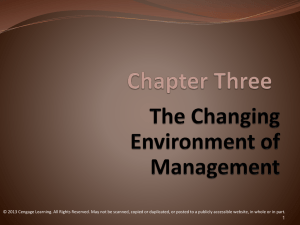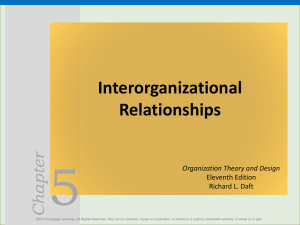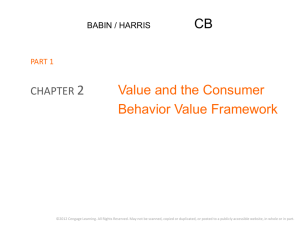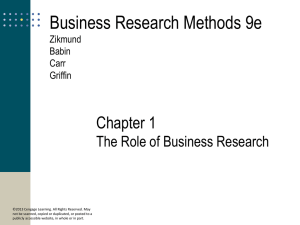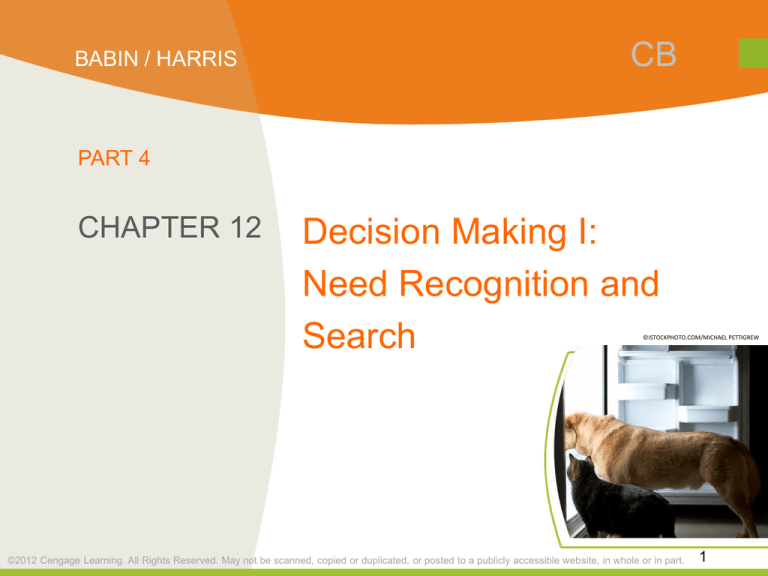
BABIN / HARRIS
CB
PART 4
CHAPTER 12
Decision Making I:
Need Recognition and
Search
©ISTOCKPHOTO.COM/MICHAEL PETTIGREW
©2012 Cengage Learning. All Rights Reserved. May not be scanned, copied or duplicated, or posted to a publicly accessible website, in whole or in part.
1
Learning Outcomes
LO1
Understand the activities involved in the consumer
decision-making process.
LO2
Describe the three major decision-making research
perspectives.
LO3
Explain the three major types of decision-making
approaches.
LO4
Understand the importance of the consideration set in the
decision-making process.
LO5
Understand the factors that influence the amount of search
performed by consumers.
©2012 Cengage Learning. All Rights Reserved. May not be scanned, copied or duplicated, or posted to a publicly accessible website, in whole or in part.
2
LO1
Understand the activities
involved in the consumer
decision-making process.
©2012 Cengage Learning. All Rights Reserved. May not be scanned, copied or duplicated, or posted to a publicly accessible website, in whole or in part.
3
LO1
Exhibit 12.1: Basic Consumption
Process and Decision-Making
©2012 Cengage Learning. All Rights Reserved. May not be scanned, copied or duplicated, or posted to a publicly accessible website, in whole or in part.
4
LO1
Exhibit 12.2: Consumer DecisionMaking Process
©2012 Cengage Learning. All Rights Reserved. May not be scanned, copied or duplicated, or posted to a publicly accessible website, in whole or in part.
5
LO1
Decision Making and Choice
Value
Motivation
Emotion
©2012 Cengage Learning. All Rights Reserved. May not be scanned, copied or duplicated, or posted to a publicly accessible website, in whole or in part.
6
LO1
Decision Making 101
The “best” schools
are not always the
best choice for
students.
© REPRINTED WITH PERMISSION OF THE PRINCETON REVIEW
©2012 Cengage Learning. All Rights Reserved. May not be scanned, copied or duplicated, or posted to a publicly accessible website, in whole or in part.
7
LO2
Describe the three major
decision-making research
perspectives.
©2012 Cengage Learning. All Rights Reserved. May not be scanned, copied or duplicated, or posted to a publicly accessible website, in whole or in part.
8
LO2
Exhibit 12.3: Perspectives on
Consumer Decision Making
©2012 Cengage Learning. All Rights Reserved. May not be scanned, copied or duplicated, or posted to a publicly accessible website, in whole or in part.
9
LO2
Rational Perspective
What is rational to
some may be
irrational to others.
Would you pay
over $1,000 for a
single season
ticket to a
basketball game?
©CJ GUNTHER/EPA/LANDOV
©2012 Cengage Learning. All Rights Reserved. May not be scanned, copied or duplicated, or posted to a publicly accessible website, in whole or in part.
10
LO3
Explain the three major types of
decision-making approaches.
©2012 Cengage Learning. All Rights Reserved. May not be scanned, copied or duplicated, or posted to a publicly accessible website, in whole or in part.
11
LO3
Involvement and Risk
Involvement
• The degree of
personal
relevance that a
consumer finds in
pursuing value
from a given act.
Types of risk
• Financial
• Social
• Performance
• Physical
• Time
©2012 Cengage Learning. All Rights Reserved. May not be scanned, copied or duplicated, or posted to a publicly accessible website, in whole or in part.
12
Exhibit
12.4
LO3 Decision-Making Approaches
©2012 Cengage Learning. All Rights Reserved. May not be scanned, copied or duplicated, or posted to a publicly accessible website, in whole or in part.
13
LO3
Habitual Decision Making
Loyalty programs,
such as reward
cards, provide
benefits for
consumers and
marketers.
PRNEWSFOTO/BEST WESTERN INTERNATIONAL
©2012 Cengage Learning. All Rights Reserved. May not be scanned, copied or duplicated, or posted to a publicly accessible website, in whole or in part.
14
LO4
Understand the importance of the
consideration set in the decisionmaking process.
©2012 Cengage Learning. All Rights Reserved. May not be scanned, copied or duplicated, or posted to a publicly accessible website, in whole or in part.
15
LO4
Need Recognition
Consumer perceives a
difference between an
actual state and a desired
state.
©2012 Cengage Learning. All Rights Reserved. May not be scanned, copied or duplicated, or posted to a publicly accessible website, in whole or in part.
16
LO4
Need Recognition States
Actual state–a consumer’s
perceived current state.
Desired state–a perceived
state for which a consumer
strives.
©2012 Cengage Learning. All Rights Reserved. May not be scanned, copied or duplicated, or posted to a publicly accessible website, in whole or in part.
17
LO4
Desired State
Desired states
changed
dramatically with
the introduction of
the iPad.
©BRENDON O’HAGAN/AFP/GETTY IMAGES
©2012 Reserved.
Cengage Learning.
Allbe
Rights
Reserved.
May or
notduplicated,
be scanned,orcopied
or to
duplicated,
posted to a website,
publicly accessible
in whole18
or in part.
©2012 Cengage Learning. All Rights
May not
scanned,
copied
posted
a publiclyoraccessible
in whole website,
or in part.
LO4
Search Behavior
Ongoing
Prepurchase
Information
Overload
Internal
External
©2012 Cengage Learning. All Rights Reserved. May not be scanned, copied or duplicated, or posted to a publicly accessible website, in whole or in part.
19
LO4
Exhibit 12.5
Consideration Set
©2012 Cengage Learning. All Rights Reserved. May not be scanned, copied or duplicated, or posted to a publicly accessible website, in whole or in part.
20
LO5
Understand the factors that
influence the amount of search
performed by consumers.
©2012 Cengage Learning. All Rights Reserved. May not be scanned, copied or duplicated, or posted to a publicly accessible website, in whole or in part.
21
LO5
External Search
• Includes the gathering of information from
external sources.
• Factors considered:
– Ease of obtaining information from the
source.
– Objectivity of the source.
– Trustworthiness of the source.
– How timely the information can be obtained.
©2012 Cengage Learning. All Rights Reserved. May not be scanned, copied or duplicated, or posted to a publicly accessible website, in whole or in part.
22
LO5
Evaluative Criteria
• The individual attributes or elements
of a product or decision that are
used by consumers in making a
decision.
• Two that are used across almost all
consumer decisions:
– Price
– Quality
©2012 Cengage Learning. All Rights Reserved. May not be scanned, copied or duplicated, or posted to a publicly accessible website, in whole or in part.
23
LO5 External Search and the Internet
Lowers search
costs
Provides hedonic
value
Information control
©VARIO IMAGES GMBH & CO. KG/ALAMY
©2012 Cengage Learning. All Rights Reserved. May not be scanned, copied or duplicated, or posted to a publicly accessible website, in whole or in part.
24
LO5 The Internet at Your Fingertips
New and popular search engines including Google and
Bing allow you to solve your problems quickly online.
Facebook provides us with the opportunity to connect
with people all over the world.
Consumers can buy directly from sponsored links on
other sites, which produces an easy online shopping
experience.
As mobile technologies continue to evolve, consumers
will be able to do everything on the go!
©2012 Cengage Learning. All Rights Reserved. May not be scanned, copied or duplicated, or posted to a publicly accessible website, in whole or in part.
25
LO5
Factors Influencing Amount of
Search
•
•
•
•
Product experience
Involvement
Perceived risk
Value of search effort
• Time availability
• Attitudes towards
shopping
• Personal factors
• Situational
influencers
©2012 Cengage Learning. All Rights Reserved. May not be scanned, copied or duplicated, or posted to a publicly accessible website, in whole or in part.
26
Exhibit 12.6
LO5 Experience and External Search
Sources: Srinivasan, Narasimhan, and Brian T. Ratchford (1991), “An Empirical Test of a Model of External Search for Automobiles,” Journal of Consumer Research,
18, 233-242; Johnson, Eric J., and Edward J. Russo (1984), “Product Familiarity and Learning New Information, “ Journal of Consumer Research, 11, 542-550;
Moore, William L., and Donald R. Lehmann (1980), “Individual Differences in Search Behavior for a Nondurable, “ Journal of Consumer Research, 7, 296-307.
©2012 Cengage Learning. All Rights Reserved. May not be scanned, copied or duplicated, or posted to a publicly accessible website, in whole or in part.
27
LO5
Search Regret
Negative emotions that come from a
failed search process. When consumers
are unable to find a solution to their
problems, the decision-making process
halts. As a result, consumers may feel
the process was a wasted effort.
©2012 Cengage Learning. All Rights Reserved. May not be scanned, copied or duplicated, or posted to a publicly accessible website, in whole or in part.
28
LO5
Pay to Play
A way to introduce new products to consumers is by
requiring marketers to pay “slotting fees” to retailers. These
fees guarantee that a new product will be placed in a
specific location in the store.
PROS:
- Balance risk
- Signal the value of the new product
- Signal the attractiveness
©ISTOCKPHOTO.COM/WEBKING
CONS:
- Represent a type of extortion
- Can violate anti-trust laws
©2012 Cengage Learning. All Rights Reserved. May not be scanned, copied or duplicated, or posted to a publicly accessible website, in whole or in part.
29



